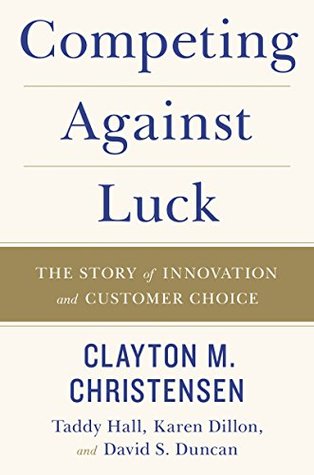More on this book
Community
Kindle Notes & Highlights
For years, I’d been focused on understanding why great companies fail, but I realized I had never really thought about the reverse problem: How do successful companies know how to grow?
Within months, something notable
happened: Nothing.
I wonder what job arises in people’s lives that causes them to come to this restaurant to “hire” a milk shake?
What job were you trying to do for yourself that caused you to come here and hire
that milk shake?”
But it soon became clear that the early-morning customers all had the same job to do: they had a long and boring ride to work.
They needed something to keep the commute interesting.
midmorning stomach rumbling.
I’m full all morning.
“Help me stay awake and occupied while I make my morning commute more fun.”
We had the answer!
You have to understand the job the customer is trying to do in a specific circumstance.
one-size-fits-none product
wet the popcorn just enough for the salt to stick.
When you consider the market for margarine from the perspective of what it was actually competing with in consumers’
minds, new avenues for growth open up.
When a customer decides to buy this product versus that product, she has in her mind, a kind of résumé of the competing products that m...
This highlight has been truncated due to consecutive passage length restrictions.
People might hire the same product to do different jobs at different times in their lives—much like the milk shake.
seen through the lens of Jobs to Be Done, the market for margarine was potentially much larger than Unilever may have previously calculated.
all this data is focused around customers and the product itself—not how well the product is solving customers’ jobs. Even customer satisfaction metrics, which reveal whether a customer is happy with a product or not, don’t give any clues as to how to do the job better.
Yet it’s how most companies track and measure success.
But I can’t help but wonder how a different lens on the competitive landscape may have altered Unilever’s path.
myriad forms of analytics—regression, factor analysis, principal components analysis, and conjoint analysis.
in spite of all this, a lot of innovation effort is ultimately assumed to be a consequence of good luck anyway.
How often do you hear a success dismissed as simply the right product at the right time?
we believe Jobs Theory provides a powerful way of understanding the causal mechanism of customer behavior, an understanding that, in turn, is the most fundamental driver of innovation success.
performed that job extremely well.
success o...
This highlight has been truncated due to consecutive passage length restrictions.
The value of Jobs Theory to you is not in explaining past successes, but in predicting new ones.
Identifying and understanding the Job to Be Done is key, but it’s just the beginning.
After you’ve uncovered and understood the job, you need to translate those insights into a blueprint to guide the development of products and services that customers will love.
Creating the right experiences and then integrating around them to solve a job, is critical for competitive advantage.
Most of the world’s most successful innovators see problems through a different lens from the rest of us.
AT&T introduced a “picture phone” at the 1964 World’s Fair, decades before Apple’s iPhone.
At its heart, Jobs Theory explains why customers pull certain products and services into their lives: they do this to resolve highly important, unsatisfied jobs that arise.
To elevate innovation from hit-or-miss
miss to predictable, you have to understand the underlying causal mechanism—the progress a consumer is trying to make in particular circumstances.
Pasteur,
in 1854, when cholera gripped London,
John Snow,
But while an improvement, Snow’s analysis still didn’t get to the root cause of what actually made those people sick.
Enter Louis Pasteur who, in the mid-1800s, conducted the critical experiments establishing that bacteria—or more simply, “germs”—were the cause of many common diseases.
first vaccines and an...
This highlight has been truncated due to consecutive passage length restrictions.
dairy products safe for c...
This highlight has been truncated due to consecutive passage length restrictions.
Why was Pasteur so successful, after hundreds of years of searching for explanations for the mys...
This highlight has been truncated due to consecutive passage length restrictions.


